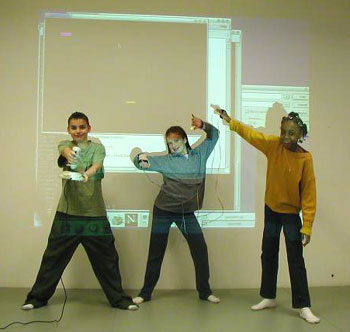
|
Kids in (Sound) Space: Introduction Douglas Repetto introduction -- technology -- process and performance -- future work Traditionally, music has been described in terms of melody, harmony and rhythm. However, in the past century or so, many people have found it useful to think about music more abstractly, using terms like "organized sound" to describe the essential nature of music. Particularly since the advent of easy-to-use sound recording technologies, artists have been exploring ways to treat sound itself as a medium, and have developed many sound manipulation techniques that are close analogs of techniques used in other art forms. It is not unusual to hear a sound artist talk about sculpting, collaging, filtering, stretching or mangling a sound. In order to organize sounds, you have to be able to describe them, to figure out what makes one different from or similar to another. There are many ways to describe a given sound: How loud is it? Is it a low sound or a high one? Where is it coming from? Is it bright or dull? Is it a static sound, or are its qualities changing over time? How? Things like loudness and frequency are fairly objective, measurable qualities of a sound. Other features are more subjective: Is the sound hard or soft? Warm or cold? Is it a scary sound? An exciting one? How big is the sound? Would you want the sound in your house? In your pocket? What color is the sound? Having described a sound's qualities, you can then treat those qualities as parameters to be used to manipulate the sound or to compare it to another sound. You might want to make a high sound lower, or a cold one warm. You might decide to juxtapose a hard sound with a soft one, or a friendly sound with a scary one. Approaching sounds in this abstract way opens up the creative possibilities of working with sound, and further, it leads to interesting ways of thinking about sounds and their parameters and the ways those sounds and parameters relate to other parts of the environment. What do a soft sound and a soft line have in common? How is a fast sound related to a fast image? What does it mean when you put a small sound in a big space?
The "Kids in (Sound) Space" project had two main goals: to get kids thinking about sounds as abstract objects with features and parameters, and to get them to think about the ways in which those parameters can be used to both change the sound and to relate it to other objects (sounds, images, light, etc.) in the environment. introduction -- technology -- process and performance -- future work
|

